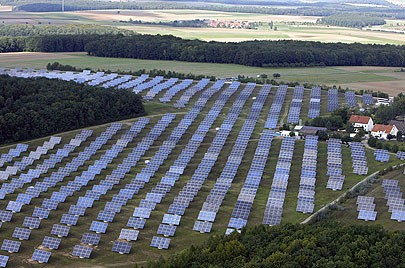I recently returned from the 27th European Photovoltaics Solar Energy Conference and Exhibition (EU PVSEC) held in Frankfurt, Germany. While my days were packed with fascinating presentations and discussions with colleagues on PV related topics such as cell design, novel materials, fabrication methods, and economic considerations, the topic which had perhaps the most lasting impression on me was Building-integrated Photovoltaics (BiPV). Now, I should clarify that BiPV is not simply just slapping on a solar panel on the roof of your house, it is integrating the PV panel as a functional component of the building envelope such as a roofing material or a semitransparent window. The case for BiPV is easy to make. We can reduce the balance of system (BOS) cost of the PV system by having the photovoltaic panels also function as a building material. For example the PV could function as both a photovoltaic power source and a roofing shingle (see Fig. 1).
Figure 1: DOW POWERHOUSETM solar shingle[1]
I have been interested in BiPV since… well… since I’ve be interested in PV but I knew very little about the topic until the EU PVSEC. During the PVSEC, I saw many presentations and had numerous discussions with researchers, industry personnel, and fellow PVIN HQP about BiPV. It was fascinating to hear the different perspectives that researchers from different backgrounds had on BiPV. I heard some researchers speak about the ecological impact of BiPV, while others spoke about the architectural potential of BiPV, however, as with most discussions involving PV, the factors of cost and conversion efficiency became the overwhelming focus. Currently, BiPV represents only a small fraction of the entire PV market and this is mainly attributed to the fact that BiPV products tend to have a higher $/Wp than standard PV panels. Now, there are several factors that contribute to this higher $/Wp including the lower production scale of BiPV products, the higher operating temperature of BiPV installations, and due to conforming to the building envelope, BiPV also tend to be installed in non-ideal orientation (i.e. not directly south facing). While the naysayers claim that this higher $/Wp of BiPV will keep it as a fringe market in the PV industry, others point out that with greater competition and production scale, the cost of BiPV will fall dramatically. Furthermore, proponents of BiPV will also point out that some PV technologies such as thin film silicon, silicon heterojunction, and CdTe have better performance at high temperatures than conventional PV and thus will improve the performance of BiPV products.
Putting the controversy of cost aside, there is certainly a strong case to be made for BiPV. During the PVSEC, I saw a presentation regarding the issues of agricultural displacement caused by large scale ground-mounted PV farms (see Fig 2). In addition there was a discussion on the ecological impact of displacing natural environment and wildlife with large-scale ground-mounted PV installations. In both cases, the solution that was researched was to attempt to install the ground-mounted panels in such as way that they can co-exist with agriculture or the natural environment. While I think this is important research to be done, I question whether a better solution to this issue would be to move towards BiPV installations.
Figure 2: Solar Farm Installation [2]
Another fascinating presentation on BiPV was given by TNC Consulting Advanced Energy Concepts. In this presentation, it was discussed that bi-facial BiPV panels installed in the east-west orientation in a building façade can help mitigate current PV grid issues such as the need for storage and peak shaving. This is because bi-facial panels installed in the east-west orientation will produce peaks in the morning and late-afternoon which combined with a conventional south facing PV installation will produce a nearly rectangular energy production profile over the course of the day. Developing solutions for the grid to accommodate the sharp mid-day production peak of conventionally installed PV panels is a major challenge that we are faced with today and thus being able to flatten out this peak to a near-rectangular profile using BiPV could be a compelling solution to this issue.
While opinions on BiPV are varied, I believe the inherent advantages of lower ecological footprint, rectangular production profiles, and perhaps lower cost will lead this technology to become a major growth sector in the PV industry.
Ph.D. Candidate – 4th Year
Department of Electrical and Computer Engineering
University of Toronto
1. Murph, D. Dow’s POWERHOUSE solar shingles get along with non-solar siblings, your HOA. 2009; Available from: http://www.engadget.com/2009/10/08/dows-powerhouse-solar-shingles-get-along-with-non-solar-sibling/.
2. Apollo Solar. Projects Agriculture 2012; Available from: http://www.apollosolar.ca/images/projects_agriculture.jpg.



